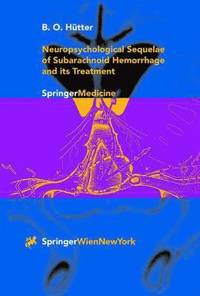
- Format
- Häftad (Paperback / softback)
- Språk
- Engelska
- Antal sidor
- 178
- Utgivningsdatum
- 2000-08-01
- Upplaga
- 2000 ed.
- Förlag
- Springer Verlag GmbH
- Medarbetare
- Seeger, W. (foreword)/Poeck, K. (foreword)/Seeger, W. (foreword)/Poeck, K. (foreword)
- Illustratör/Fotograf
- Mit Abb
- Illustrationer
- 6 Illustrations, black and white; XVI, 178 p. 6 illus.
- Dimensioner
- 234 x 156 x 11 mm
- Vikt
- Antal komponenter
- 1
- Komponenter
- 1 Paperback / softback
- ISBN
- 9783211834428
- 281 g
Neuropsychological Sequelae of Subarachnoid Hemorrhage and its Treatment
- Skickas från oss inom 7-10 vardagar.
- Fri frakt över 249 kr för privatkunder i Sverige.
Passar bra ihop
De som köpt den här boken har ofta också köpt Love Life av Matthew Hussey (häftad).
Köp båda 2 för 1774 krKundrecensioner
Recensioner i media
"... Das Buch ist ... empfehlenswert fur alle Arzte und Vertreter anderer Disziplinen, die sich im Rahmen von medizinischer Versorgung, Rehabilitation oder Forschungstatigkeit mit SAB-Patienten befassen. Es liefert dem Leser fundierte Information und wertvolle Anregungen." Der Nervenarzt 6/2001
Innehållsförteckning
1. Introduction.- 2. Clinical appearance, pathology and diagnostics of subarachnoid hemorrhage (SAH).- 2.1. Definition, epidemiology and etiology.- 2.2. Epidemiology of SAH as a result of the rupture of an aneurysm and of spontaneous SAH without a proven source of the bleeding.- 2.3. Pathophysiology of SAH.- 2.4. Clinical features of acute SAH.- 2.5. Diagnostics of acute SAH.- 2.6. The most common classification systems to assess the state of a patient and the severity of SAH.- 2.7. Natural course of SAH.- 3. Therapy of SAH.- 3.1. General principles.- 3.2. Operative therapy of ruptured intracranial aneurysms.- 3.3. Postoperative mortality after aneurysm rupture.- 4. Special aspects of the pathology and therapy of SAH.- 4.1. The importance of the anatomical distribution of the hemorrhage.- 4.2. Intraventricular hemorrhage.- 4.3. Intracerebral hemorrhage.- 5. Cerebral vasospasm after SAH.- 6. Early surgery of patients grade IV or V after Hunt and Hess.- 7. Neuropsychological sequelae of SAH.- 7.1. Early studies on the neuropsychological sequelae of SAH.- 7.2. The discrepancy between a good neurological state and the neuropsychological impairments in patients after SAH.- 8. Basics of scientific research on the neuropsychological sequelae of subarachnoid hemorrhage.- 8.1. General methodological considerations.- 8.2. Strengths and weakness of neuropsychological measures in patients after SAH.- 8.3. The measurement of health-related quality of life of patients after SAH by means of the Aachen Life Quality Inventory (ALQI).- 8.4. Disturbances of affectivity and personality in patients after brain damage.- 8.5. The assessment of psychological adjustment after SAH by means of the revised Freiburger Personality Inventory (FPI-R).- 9. The pattern of cognitive deficits in the chronic state after subarachnoid hemorrhage.- 9.1. Impact on general intelligence.- 9.2. Cognitive deficits after SAH.- 10. Neuropsychological effects of aneurysm location.- 10.1. Are there specific neurobehavioral sequelae depending on the localization of the ruptured aneurysm?.- 10.2. Disconnection syndromes after aneurysm rupture.- 10.3. Cognitive deficits after rupture and surgical treatment of an aneurysm of the ACoA.- 11. Impairments in daily life after SAH.- 12. Psychological adjustment and depression after SAH.- 13. Ability to work and professional performance capacity in patients after SAH.- 14. Neurobehavioral sequelae of SAH without a proven source of the bleeding in comparison to the sequelae of the rupture of an intracranial aneurysm.- 14.1. Comparison of the cognitive deficits in both patient groups.- 14.2. Comparison of the impairments in quality of life between operated patients and those with SAH without a proven source of the bleeding...- 15. Neuropsychological sequelae of aneurysm surgery.- 16. Neurobehavioral sequelae of the anatomical bleeding pattern.- 17. Short- and long-term effects of disturbed CSF circulation after SAH.- 18. Health-related quality of life in patients who had been in Hunt and Hess grades IV or V on admission to the neurosurgical unit.- 19. Vasospasm: a risk factor for neuropsychological impairments after SAH?.- 20. Prognostic factors of the neurobehavioral late result after SAH.- 21. SAH as a psychological trauma.- 22. Problems of rehabilitation of patients after SAH.- 22.1. Spontaneous functional regeneration after SAH.- 22.2. General elements of rehabilitation after SAH.- 22.3. Scientific studies on the effectiveness of neuropsychological rehabilitation measures in patients after SAH.- 23. Closing discussion and outlook.- 24. References.
Du kanske gillar
-
Atomic Habits
James Clear
HäftadBad Therapy
Abigail Shrier
InbundenFrågor & svar


